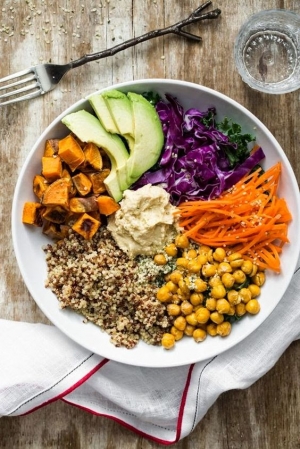
yogalign.co.nz admin
Natural Ways To Manage Period Pain
Natural Ways To Manage Period Pain
Queasiness and stomach cramps often go hand in hand with menstruation, and while painkillers may temporarily provide relief there are natural ways you can ease discomfort. Susan Johns, clinical dietician and distributor of Lunette in New Zealand shares her top tips for managing period pain naturally.
Why whole grains?
Whole grains are complex carbohydrates that stimulate the brain in order to release serotonin, a hormone which makes you feel good. Ever notice that your body feels like it took a thrashing from the inside-out about a week before your period is due? Studies have shown that whole grains can reduce that tension and fight depression because they are loaded with vitamin E and magnesium.
Put it on your plate – almonds, spinach, quinoa, cashews
Your best spud
Vitamin A plays a huge role in saying goodbye to our PMS symptoms. An increase in Vitamin A will fight PMS symptoms, like acne and heavy bleeding, as well as problems that occur like fatigue when vitamin A levels plummet. One sweet potato provides 120% of our daily recommended intake of Vitamin A.
Put it on your plate – kumara, carrots, kale
The good kind of fat
Good fats make good hormones; bad fat makes bad hormones. Simple, right? Keep your saturated fat intake low and boost your intake of unsaturated fats, especially in the week leading up to your period. This’ll help keep your hormones happy.
Put it on your plate – avocado, coconut and olive oil, whole eggs, salmon
Cereal killer
B vitamin deficiency, particularly B6, is known to play a role in increasing PMS symptoms such as forgetfulness, irritability, anxiety, insomnia, and moodiness. Add period pain to the mix and your day just got a whole lot worse.
Put it on your plate – fortified breakfast cereals, chickpeas, chicken, tuna, banana
Nuts about nuts
While your uterus is busy cramping your style, the muscle lining can get fatigued and develop a lactic acid build up, just like your legs after an intense session at the gym. Magnesium, found in high concentration in nuts, is key here to give relief to cramping pains.
Put it on your plate – nuts, pumpkin seeds, dark chocolate, spinach, fish
Zinc overdose
Upping your intake of zinc-rich foods a few days before you are due has been shown to have a positive effect on cramps, bloating and inflammation. Zinc needs vitamin B6 to be absorbed, so be sure to pair your zinc-filled foods with foods rich in B vitamin.
Put it on your plate – peas, asparagus, spinach, red meat, seafood.
The Importance Of Sleep - Part 4
"If every 8 year old in the world is taught meditation, we will eliminate violence from the world within one generation." - Dali Lama
EVENING DINACHARYA, PART 4: PRACTICES FOR BETTER SLEEP
By Shyam Kumar for Yogibeings
In Part 1, we looked at how a consistent sleep routine enhances the quality of rest and rejuvenation. In Part 2, we focused on synchronising our sleep routine with nature’s doshic rhythm and in Part 3, we looked at practices that help you relax in the evening. Now we look at some more evening routines for better sleep.
Avoid backlit screens
Turn of all electronic devices at least an hour before bedtime. Backlit screens interfere with your biological clock and fool your body into thinking its daytime, straining your eyes and stimulating your mind. Spend this time with yourself. Indulge in soothing meditation or self-reflection, listen to relaxing music, or read an uplifting book (although not in bed!).
Avoid reading in bed
Reading in the bed can confuse the body by signalling for sleep and alertness at the same time. Designate a place to sit down and read. Avoid reading excessively emotional or distressing content. If you struggle with sleeping, try giving up bedtime reading.
Keep a journal
Spend a few minutes writing about your day to clear your mind and remove any residual emotions associated with the day’s events.
A soothing glass of milk
If your system allows it, drink a glass of warm milk, with a pinch of cardamom and honey, to promote deep sleep.
Relax your body
Once in bed, consciously relax your entire body. Bring your awareness to each part of the body and will it to relax itself. Then focus on your breathing and gently drift into sleep.
Sleep according to your dosha
Vata types may suffer from irregular sleep routines and have to take extra effort to establish a daily sleep routine. Go to bed at the same time every day, even if you don’t feel sleepy. Sleep on your left side to encourage breathing through your right nostril, to promote heat.
Pitta types tend to easily get disturbed from their sleep. Keep your bedroom quiet and fragrant. Sleep on your right side to encourage breathing through your left nostril, for cooling.
Kapha types have a tendency to oversleep and this causes imbalance. Ensure you wake up before 6 am. Sleep on your left side to promote heating.
Incorporating all these practices into your daily life may sound daunting. Choose a few of these that appeal to you most and commit to doing them every day. As you become comfortable, you can gradually add more practices into your routine. Observe how your body feels and celebrate the small improvements—these are your body’s way of thanking you.
Broken Brain - Weekly showing of a Ground Breaking 8-part Docuseries
Here at the YogAlign Yoga Studio in Mount Maunganui, I will be showing the Broken Brain 8-Part Docuseries, Heal Your Body, Heal Your Brain.
Host Dr Mark Hyman has brought together the world's top experts on brain health to bring you the most cutting edge information & research on brain health.
Broken Brain is an 8-Part Docuseries that addresses the root causes of our biggest brain challenges, how to really go about healing them, & how to optimise your brain function. We refer to our "Broken Brain" by many names - Alzheimer's, depression, anxiety, memory loss, brain fog, attention deficit disorder or ADD, autism & dementia - just to name a few.
If you (or your family & friends) are looking to achieve more mental clarity & become sharper, more focused & more joyful, you won't want to miss this documentary. Everyone Welcome!
You don't have to suffer with a Broken Brain anymore!
I will be playing the 8-Part docuseries hosted by Dr Mark Hyman, over 8 evenings.
Episode 1 The Broken Brain Epidemic / My Story - Thursday 12 April
Episode 2 Gut Brain Connection: Getting to The Root of a Broken Brain - Thursday 19 April
Episode 3 Losing Our Minds - Alzheimer's, Dementia & MS - Thursday 26 April
Episode 4 ADHD & Autism - Thursday 3 May
Episode 5 Depression & Anxiety - Thursday 10 May
Episode 6 Traumatic Brain Injury - Accidents, Sports & More - Thursday 17 May
Episode 7 7 Steps to An UltraMind (Part 1) - Thursday 24 May
Episode 8 7 Steps to An UltraMind (Part 2) - Thursday 31 May
Venue: YogAlign Studio, 125 Oceanbeach Road, Mount Maunganui
Time: 7pm start - bring a pillow or bolster for your comfort (we have some available :) and pen & paper
Cost: $5 per single session or $20 for the full 8-part docuseries
Dates: Thursday evenings starting Thursday 12 April to Thursday 31 May 2018
The Importance Of Sleep - Part 3
EVENING DINACHARYA, PART 3: RELAXING ROUTINES
By Shyam Kumar for Yogibeings
In Part 1, we looked at how Ayurveda considers sleep to be essential for good health and how establishing a consistent sleep routine goes a long way in enhancing the quality of rest and rejuvenation. Part 2 explained how the night is governed by different doshas at different times and how to synchronise your sleep routine with nature’s rhythm. Now, let’s look at establishing a soothing evening routine to help you wind down and prepare for a night of restful sleep.
Following a regular routine reassures your body that everything is well, providing a tremendous sense of comfort. Establishing a daily evening routine ensures that, with time, the body learns that these are signals that the day is ending and to prepare for a good night’s rest. It’s important to be consistent with the routine. Here are some things that you can incorporate into your evening routine:
Avoid that evening cup of coffee
Drinking coffee or any other stimulant prevents your brain from responding to fatigue, instead making you feel fresh and energetic. This causes problems in trying to sleep early. If you are suffering from sleep-related problems, cutting down on caffeine may go a long way in helping you sleep better.
Turn down the lights
Our biological clocks are highly sensitive to light. For most living beings, sunset is a signal that the day is winding down and it’s time to rest. In today’s modern life, there is so much artificial lighting that it severely interferes with the natural biological response to sleep. One of the best things you can do is to dim the lights at home as the sun goes down. This sends the signal to your body that the day is ending.
Reduce exertion
It’s best to reduce strenuous physical and mental activity at least two hours before bedtime.
Have an early dinner
Have an early dinner to ensure that the food is completely digested before you sleep. This prevents the accumulation of toxic waste (ama) in your body, which could make you feel dull and lethargic. It’s ideal to leave a gap of three hours between dinner and sleep time. To get used to eating early, you can begin by eating a lighter dinner than usual.
Wash your face
Wash your face with lukewarm water, preferably using an Ayurvedic cleanser. This cleanses the dirt accumulated through the day, removes oil from the pores and helps your skin breathe at night.
Massage your feet and scalp
Take a few drops of oil and do a slow, relaxing massage of your scalp. Wash and dry your feet and apply a few drops of oil slowly from heel to toe in slow, circular movements of your palm. This removes excess heat and relaxes the entire body.
In Part 4, we shall look at a few more things you can do before bedtime and how to incorporate these into our daily lives.
The Importance Of Sleep - Part 2
EVENING DINACHARYA, PART 2: THE DOSHIC NATURE OF SLEEP
By Shyam Kumar for Yogibeings
In Part 1, we looked the vital role of sleep in maintaining overall health, improving immunity and enhancing cognitive function. Establishing a consistent sleep and wake time goes a long way in enhancing the quality of rest and rejuvenation. Now, let’s see how different parts of the night are governed by different doshas, and how to synchronise our sleep routine with nature’s rhythm.
Ayurveda divides each day into two cycles:
1) The solar cycle which begins at 6 am and ends at 6 pm.
2) The lunar cycle which begins at 6 pm and ends at 6 am.
The lunar cycle plays an important role in establishing sleep rhythm. This twelve-hour period is divided into three intervals of four hours each. The first interval from 6 pm to 10 pm is dominated by Kapha, the second interval from 10 pm to 2 am is dominated by Pitta, and the third interval from 2 am to 6 am is dominated by Vata. This fundamental understanding, along with knowledge of the current season and your doshic constitution helps establish a proper evening routine that is in harmony with the doshic influences.
Ayurveda recommends going to sleep before 10 pm. During this time our bodies are dominated by Kapha’s earthy, stable and grounding properties—ideal for a deep, soothing sleep. The period from 10 pm to 2 am is dominated by Pitta, whose qualities are intense, hot, sharp and acidic. This might make you feel energetic, impatient to be active, and prevent you from falling asleep. Staying awake at this time causes a phenomenon called second wind, where you stop feeling drowsy even when you are exhausted. Moreover, Pitta increases the digestive fire and leaves you craving that midnight snack!
The time dominated by Pitta is used by the body to repair its tissues, clean out toxins, enhance your immune system and perform daily maintenance tasks. This is also when the mind processes the undigested thoughts and emotions caused during the day and comes to terms with them.
Pitta gives way to Vata dominance at around 2 am and the atmosphere is dominated by qualities of lightness, mobility and coolness. The body begins the process of waking up around this time. Ayurveda advises getting up an hour and a half before sunrise when Vata dominates, so you can begin the day feeling light and refreshed.
Sleeping fewer hours in harmony with these cycles can leave you feeling more relaxed and energetic than sleeping longer hours going to bed late. However, falling asleep early is not easy for many of us. In Part 3, we look at establishing a simple evening routine that helps us to wind down and get ready for a night of soothing sleep.
The less you respond to negativity the more peaceful your life becomes
The Importance Of Sleep - Part 1
EVENING DINACHARYA, PART 1: THE IMPORTANCE OF SLEEP
By Shyam Kumar for Yogibeings
Do you wake up in the middle of the night, fully awake and unable to go back to sleep? Do you start your mornings in a state of exhaustion? Do you find yourself unable to fall asleep at night even though you are tired? Most of these stem from our irregular work schedules which have made food and sleep patterns and our lifestyle in general increasingly erratic. These irregularities affect our metabolic rhythm and lead to tiredness, heartburn, loss of appetite and other health complications.
Ayurveda highly recommends establishing a daily rhythm, “Dinacharya", taking into account your constitution and the cycles of nature. Adhering to Dinacharya ensures tri-doshic balance and provides a deep sense of relaxation, enhancing overall wellness. In this series, we will be looking at establishing a daily evening rhythm that leads to restful sleep.
Sleep is of fundamental importance in Ayurveda. It allows the body and mind to relax deeply, detoxify and rejuvenate. This is the time the body needs for tissue repair, muscle growth, removal of metabolic wastes, and enhancing immune function. Quality of sleep has a direct impact on our cognitive functions including level of attention and our ability to learn. Therefore it’s vital to get a good night of sleep.
Ayurveda gives no universal recommendation for the ideal duration of sleep. Based on your constitution, this may vary between 6-8 hours. Kapha predominant body types need little sleep and Vata types need the most. Too much sleep can imbalance doshas and causes dullness and lethargy. More than eight hours of sleep are recommended only for pregnant women, the aged and the sick.
Merely sleeping the right number of hours isn’t enough to ensure good sleep quality. It’s important to establish a consistent sleep routine with predictable sleep and wake times. This helps the body settle into a daily rhythm. Once you have understood the duration of sleep required for you, fix a wake up time, preferably early in the morning. Then work backwards to decide on your sleep time. Regularly adhering to these times creates a deep rhythm in the body and leads to a night of relaxing and refreshing sleep.
In Part 2, we shall explore the doshic nature of each part of the night and how it affects our sleep rhythm. Adjusting our sleep routine according to these greatly enhances the quality of rest.
The 5 components that make every meal gut-healing
By Robyn Youkilis 28 February 2018
I created my Good Gut Rule of Five to show you exactly what to put on your plate at lunch and dinner. Eating in this way will ensure that you are getting a balance of both macro- and micronutrients, as well as my favorite gut-healing superfoods (which I talk about more in my book, Thin From Within). Aim to include one ingredient from each of the five categories that follow for a complete and balanced meal:
1. Greens:
Kale, collards, arugula, spinach, lettuce...I love ’em all. Aim to have at least two or three big handfuls of greens with most meals. Greens do it all when it comes to gut health and weight loss: They are packed with fiber, which helps fill you up and keep you regular. Plus, leafy green veggies are some of the most nutrient-dense foods, and when you are filling your cells with nutrients (I mean real nutrition, not just calories!), you have more energy and fewer cravings.
2. Healthy fat:
Avocado, olive and flax oils, almonds, butter from grass-fed cows (so the cows have healthy guts too!), and coconut oil all count here. Add 1 to 2 tablespoons of oil, 1 to 2 ounces of nuts, or ¼ to ½ of an avocado at each meal for a good dose of flavor and satiation. Plus, fats are essential for proper absorption of most vitamins and minerals. I used to be terrified of fats, but now I include them at every meal and am lighter than I’ve ever been.
3. Protein:
Wild salmon, grass-fed beef, organic chicken, tempeh, sprouted lentils, and canned wild sardines are some examples of great go-to protein options. Protein keeps you full and stabilizes your blood sugar, so you won’t keep dipping into your raw chocolate stash or crash halfway through your afternoon meetings.
4. Fermented food:
Including fermented foods on your plate is the good-gut secret to weight loss through a healthy microbiome (you need all that great bacteria throughout the day to keep your digestion humming!). Examples include raw sauerkraut, fermented beets, fermented carrots or radishes, and kimchi. Try adding 1 to 3 tablespoons at each meal, and feel free to work your way up to ½ cup or more. If you’re not used to the flavor of fermented veggies, try mixing them with avocado to mellow the flavor.
5. Cooked vegetables:
Having a cooked veggie or two with my meal (in addition to greens) always makes the meal feel more grounding and filling. Roasted zucchini, broccoli, sweet potatoes, squash, and carrots are all examples of delicious cooked veggies, but this can really be any veggie. I try to roast a bunch of seasonal veggies at least once or twice per week so I always have some cooked veggies on hand and ready to go. If you’re on the run, many takeout spots and fancy restaurants have awesome veggie choices these days.
Forest Bathing
How Being In The Forest Actually Boosts Immunity, According To Science
Clemens Arvay, MSc
19 February 2018
New research, like the Journal of Adolescent Health study that found that teens who have more access to green space tend to be happier, continues to reinforce the idea that humans are intricately connected to the natural environment. Our entire body is constantly communicating and acting in tandem with our surroundings. But how can something as simple as spending time outside possibly make us healthier? Let's dive into the science.
The real reason being outside is so healing.
The Japanese tradition of Shinrin-yoku, "taking in the forest atmosphere" or "forest bathing," is proof of concept. In this case, the term "bathing" does not mean swimming in some sort of wooded lake. Instead, it's about diving into a forest with all of our senses. In 1982, the National Forest Authorities of Japan suggested advertising Shinrin-yoku to the public and promoting its immune-boosting powers. And today, taking in the forest atmosphere is officially a recognized method of preventing disease and supplementing treatment in the country. The National Institute of Public Health of Japan promotes Shinrin-yoku, universities study it, and hospitals use it as an Rx.
When you breathe in the woods, you are inhaling a cocktail of bioactive substances released by plants. One of these groups of substances is called terpenes. They're usually emitted from leaves, pine needles, tree trunks, and the thick bark of some trees. We absorb these gaseous terpenes partially through our skin, but especially through the lungs. Terpenes also flow out of bushes, herbs, and shrubs among the understory, along with mushrooms, mosses, and ferns, too. Even thin layers of foliage on the forest floor emit them. So, safe to say, if you're outside and can see any sort of tree material, you're getting a dose of terpenes.
While forest medicine is under no circumstances a replacement for conventional medical check-ups, scientific studies have discovered the forest air is like an old friend to our bodies. Some of these terpenes have been found to have anti-inflammatory, anti-tumorigenic, and neuroprotective activities, making forest air like a healing elixir we inhale. Even though terpenes come from trees, mushrooms, and herbs that are communicating with one another, our immune system can also decode them. Like other plants, we respond to terpenes by strengthening our body's defenses. Doctors of forest medicine know that anti-cancer terpenes have a direct impact on the immune system as well as an indirect impact on the endocrine system. For example, they help us deal with stress by lowering our cortisol levels.
Forest bathing has also been found to enhance something called natural killer cells, another defense against diseases like cancer. Those who spend merely one day in the forest will have more natural killer cells in their blood for seven days thereafter. Those who are in the woods for two or three days have elevated levels for another 30 days. It's incredible to think that we get these long-lasting health benefits simply by existing in the woods. We don't have to go on a trail run or rigorous hike (though those things are great too); just breathing and being in communion with trees is enough.
This knowledge totally changed the way I look at nature. Now, when I walk through the woods, I feel like I’m diving into an enormous living organism. I'm becoming a part of it, and we're breathing and communicating together.
Practical ways to make your next trip into the forest even more fulfilling:
1. The content of the anti-cancer terpenes in the forest air changes over the seasons. The highest concentration is in summer, and the lowest is in winter. They increase rapidly in April and May and reach their peak in June and August. Try to go out during these months if you can!
2. You can find the highest concentration of terpenes in the middle of the forest since tree population is the densest there. This dense canopy prevents gaseous terpenes from escaping too. Try to go farther into the woods instead of lingering on the edges when you can.
3. When the air is moist—after rain or during fog, for example—a particularly large amount of healthy terpenes will be swirling around the atmosphere. So if you've ever felt especially great during a walk in the woods after a rain shower, you're not alone!
Balancing Act
The Freedom to live a Healthy Life requires commitment, planning, action & resilience.
Periodically re-evaluate your growth in the following areas to find your Optimal Wellness.
- Eat nutritious, seasonal wholefoods, mostly organic or spray free
- Allow yourself adequate rest & quality sleep
- Cultivate a peaceful but alert mind, open to love, joy & growth
- Social connection with family, friends & colleagues
- Regular exercise & a movement rich life including time out in nature
- Minimise exposure to environmental toxins
Contact Leonie Main
m: +64 (0) 274 96 96 33
19B Golf Road, Mount Maunganui 3116, New Zealand
Facebook: Gypset Life












